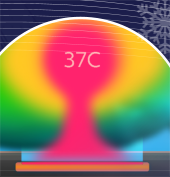
The temperature of preterm neonates must be maintained within a narrow window to ensure their survival. Continuously measuring their core temperature provides an optimal means of monitoring their thermoregulation and their response to environmental changes. However, existing methods of measuring core temperature can be very obtrusive, such as rectal probes, or inaccurate/lagging, such as skin temperature sensors and spot-checks using tympanic temperature sensors. This work investigates an unobtrusive method of measuring brain temperature continuously using an embedded zero-heat-flux (ZHF) sensor matrix placed under the head of the neonate. The measured temperature profile is used to segment areas of motion and incorrect positioning, where the neonate’s head is not above the sensors. We compare our measurements during low motion/stable periods to oesophageal temperatures for 12 preterm neonates, measured for an average of 5 hours per neonate. The method we propose shows good correlation with the reference temperature for most of the neonates. The unobtrusive embedding of the matrix in the neonate’s environment poses no harm or disturbance to the care work-flow, while measuring core temperature. To address the effect of motion on the ZHF measurements in the current embodiment, we recommend a more ergonomic embedding ensuring the sensors are continuously placed under the neonate’s head.

